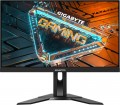Surface treatment
Modern monitors can use displays with both glossy and matte screen surfaces.
A matte surface is in some cases more preferable due to the fact that on a
glossy screen, when exposed to bright light, noticeable glare appears, sometimes interfering with viewing. On the other hand, glossy screens offer better picture quality, higher brightness, and richer colours.
Due to the development of technology,
monitors with a special anti-glare coating have appeared on the market, which, while maintaining all the advantages of a glossy screen, creates significantly less visible glare in bright ambient light.
Static contrast
Static contrast provided by the monitor screen.
This value describes the difference between the brightest whites and darkest blacks that the screen is capable of producing. In this case, unlike dynamic contrast (see below), the difference is indicated on the condition that the brightness of the screen backlight remains unchanged. In other words, this is the contrast that is guaranteed to be achievable within one frame. Static contrast is inevitably lower than dynamic. However, it is she who describes the basic capabilities of the screen.
The minimum static contrast ratio for tolerable image quality is considered to be 250:1, but even the most modest modern monitors give out about 400:1 (and a value of
1000:1 is not the highest class), and in high-end models this figure can reach 2000:1 and even more. .
Colour space (sRGB)
Monitor colour gamut Rec. 709 or sRGB.
Any colour gamut is indicated as a percentage, however, not relative to the entire variety of visible colours, but relative to the conditional colour space (colour model). This is due to the fact that no modern screen is able to display all the colours visible to humans. However, the larger the colour gamut, the wider the monitor's capabilities, the better its colour reproduction.
Nowadays, sRGB is actually the standard color model adopted for computer technology; This is what is used in the development and production of most video cards. For television, the Rec. standard, similar in parameters, is used. 709. In terms of the range of colors, these models are identical, and the percentage of coverage for them is the same. In the most advanced monitors it can
reach or even exceed 100%; These are the values that are considered necessary for high-end screens, incl. professional.
Colour space (DCI P3)
Colour gamut of the monitor according to the DCI P3 colour model.
Any colour gamut is indicated as a percentage, however, not relative to the entire variety of visible colours, but relative to the conditional colour space (colour model). This is due to the fact that no modern screen is able to display all the colours visible to humans. However, the larger the colour gamut, the wider the monitor's capabilities, the better its colour reproduction.
DCI P3 is a professional colour model used primarily in digital cinemas. It is noticeably more extensive than the standard sRGB, which gives better and more accurate colours. Accordingly, the percentage values are smaller — for example, 115% of sRGB coverage corresponds to approximately 90% of DCI P3 coverage; in the most advanced modern monitors, coverage according to this standard is
98 – 100%. At the same time, DCI-P3 support is not cheap, and therefore it is found mainly in high-end monitors for professional and gaming purposes.
HDR
This technology is designed to expand the range of brightness reproduced by the monitor; Simply put, an HDR model will display brighter whites and darker blacks than a "regular" display. In fact, this means a significant improvement in colour quality. On the one hand, HDR provides a very "live" image, close to what the human eye sees, with an abundance of shades and tones that a normal screen cannot convey; on the other hand, this technology allows to achieve very bright and rich colours.
Modern HDR monitors may use the DisplayHDR designation. This standard takes into account a number of parameters that determine the overall quality of HDR performance: brightness, colour gamut, colour depth, etc. Based on the results of measurements, the monitor is assigned one of the following markings:
DisplayHDR 400 means relatively modest HDR capabilities,
DisplayHDR 600 is average,
DisplayHDR 1000 is above average,
DisplayHDR 1400 is advanced. At the same time, the absence of a DisplayHDR label in itself does not mean anything: it’s just that not every HDR monitor is tested according to this standard.
Note that for the full use of HDR, you need not only
the appropriate monitor, but also content (movies, television, etc.) originally created in HDR. In addition, there are several different HDR techn
...ologies that are not compatible with each other. Therefore, when buying a monitor with this function, it is highly desirable to clarify which version it supports.Power consumption
Rated power consumption of the monitor. Usually, this item indicates the maximum power that the device can consume during normal operation — that is, the energy consumption at maximum brightness, the highest volume of the built-in acoustics, etc. Actual power consumption can be noticeably lower, however, when choosing, it is still best to focus on the value stated in the specifications.
In general, the lower the power consumption, the more economical the device in terms of electricity consumption (ceteris paribus). In addition, this characteristic can be useful when selecting an uninterruptible power supply for a PC and in other specific situations when it is necessary to accurately determine the power consumption of equipment.

